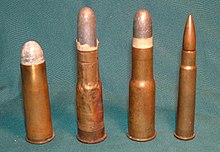Martini–Henry
In the original chambering, the rifles fired a round-nosed, tapered-head .452-inch, soft hollow-based lead bullet, wrapped in a paper patch giving a wider diameter of .460 to .469-inch; it weighed 485 grains.A sword bayonet was standard issue for non-commissioned officers; when fitted, the weapon extended to 68 inches (1,727 mm) and weight increased to 10 pounds 4 ounces (4.65 kg).[7] A bayonet designed by Lord Elcho was intended for chopping and other sundry non-combat duties, and featured a double row of teeth so it could be used as a saw; it was not produced in great numbers and was not standard issue.The .577/.450 turned out to be poorly suited to the hopper feed as well as existing box magazines due to a very pronounced bottleneck, so in 1881 the Gatling cartridge was tried in Martini-Henry rifles.[10][12] However, before this was complete, the decision was made to replace the Martini–Henry rifles with the .303 calibre bolt-action magazine Lee–Metford, which gave a considerably higher maximum rate of fire.After investigating the matter, the British Army Ordnance Department determined the fragile construction of the rolled brass cartridge, and fouling due to the black-powder propellant, were the main causes of this problem.English hunters on various safaris, mainly in Africa, found the Martini using a cordite charge and a 500-grain full-metal-jacketed bullet effective in stopping large animals such as hippopotamus up to 80 yards away.By the 1880s the .577/.450 Boxer Henry round was recognised by the NRA as a 900-yard cartridge, as shooting the Martini out to 1,000 yards or (3⁄4 of a mile) was difficult, and took great skill to assess the correct amount of windage to drop the 485 grain bullet on the target.cartridge, which was found to be much more accurate, and thus interest in the .577/450 fell away, to the point that by 1909 they were rarely used at Bisley matches, with shooters favouring the later Lee–Enfield bolt action magazine rifles.[13] In 1879, however, it was generally found that in average hands the .577/450 Martini–Henry Mk2, although the most accurate of the Martinis in that calibre ever produced for service life, was really only capable of hitting a man-size target out to 400 yards.The 415-grain Martini Carbine load introduced in 1878 shot better out to longer ranges and had less recoil when it was fired in the rifles, with its reduced charge of only 75 grains of Curtis & Harvey's.It is clear from early medical field surgeons' reports that at 200 yards the rifle really came into its own, and inflicted devastating and horrific wounds on the Zulus in the Anglo–Zulu War.A noticeably different variant incorporating earlier Westley Richards ideas for a flat-spring driven hammer within the receiver in lieu of the coil-spring powered striker of the von Martini design, known as the Gahendra rifle, was produced locally in Nepal.It was discovered that criminals in Egypt were jury-rigging shotguns they had captured or stolen by wrapping common civilian 16-gauge shells with thick paper to allow them to fit the bore.[20] Greener also used the Martini action for the GP ("General Purpose") single-barreled shotgun firing standard 12-bore 2+1⁄2 or 2+3⁄4-inch ammunition, which was a staple for gamekeepers and rough shooters in Britain.Two models of the GP was produced, Mark I and II, with the only major exterior difference being a bulkier safety lever and reversing the takedown screw's orientation.The firing mechanism consists of a helical spring around a pointed metal striker, the tip of which passes through a hole in the face of the block to impact the percussion-cap of the inserted cartridge.






A: ready for loading.
B: loaded and ready to fire.
Martini-Henry (horse)Swedish Army MuseumService rifleShotgunBritish colonial warsPerak WarSecond Anglo-Afghan WarArgentine Civil WarsHerzegovina Uprising (1875–1878)Russo-Turkish WarWar of the PacificAnglo-Zulu WarFirst Italo-Ethiopian WarNorth-West RebellionGreco-Turkish War (1897)First Boer WarSecond Boer WarBalkan WarsWorld War IGreco-Turkish War (1919–22)The TroublesWar in Afghanistan (1978–present)Nepalese Civil WarFriedrich von Martini£2/2/–BarrelCartridge.577/450 Martini–Henry.303 British7.65×53ActionFalling BlockRate of fireMuzzle velocitybreech-loadinglever actionBritish ArmySnider–EnfieldBritish EmpirePeabody riflepolygonal riflingAlexander HenryNorth-West Frontier ProvinceRoyal Small Arms FactoryAfridiKhyber PassPass-made rifles.577 SniderZulu Wargrainsriflingbayonetsocket-type spikeLord Elchobolt-actionmagazineLee–Metfordblack-powdercarbineMartini–MetfordMartini–EnfieldsBattle of Isandlwana24th Regiment of Footbattle of Rorke's DriftKynochNational Rifle AssociationBisley, SurreyLee–EnfieldBattle of UlundiAnglo–Zulu WarWestley Richardsobservation balloonsincendiary ammunitionGreenerEgyptian police'sRoyal Armouries Museumblank cartridgeOttoman EmpireProvidence Tool CompanyRusso-Turkish War (1877–1878)Hekimoğlufolk songsFirst World Warknuckle jointWerndl–Holub rifleAustria-HungaryUnited KingdomFusil Gras mle 1874FranceMauser Model 1871GermanyM1870 Italian VetterliJarmann M1884Norway and SwedenBerdan rifleRussiaSpringfield model 1884United StatesAfghanistanSoviet invasionUnited States MarinesTalibanMarjahArgentinaBoliviaKhedivate of EgyptEthiopian EmpireEgyptian-Ethiopian WarKingdom of GreeceProvisional Irish Republican ArmyRhodesiaKingdom of RomaniaMahdist SudanUlster VolunteersBritish military riflesSwinburn–HenryMartini–Enfield.303 calibreMartini Cadettarget shootingParliamentary Debates (Hansard)Greenwood Publishing GroupThe New York TimesAmerican RiflemanYouTubeVictorian era